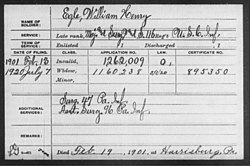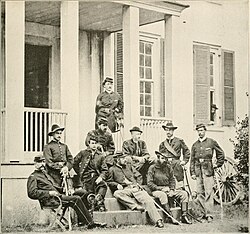
U.S. Civil War Records contain information pertaining to the people from all states at the time who served during a civil war that lasted from April 12, 1861 to April 9, 1865.[1] There were eleven states that sided with the Confederate States of America and twenty-five states that sided with the Union,[2] five of those were considered border states because they never seceded from the Union. The reasons for the war were states rights and slavery. The president during the civil war was Abraham Lincoln. Lincoln served as president from March 4, 1861 until his assassination on April 15, 1865.[3] Those that served during the U.S. Civil War came from all walks of life, including the enslaved. Many families had more than one family member that went to war and there were many family members who fought on opposite sides. Researching your ancestors who fought on the U.S. Civil War should be part of your genealogy research plan, as there are records available to them from service records to pension records, maps and photographs. Documenting this aspect of our ancestors lives and service will help us to tell our ancestor’s story.
Where to start researching for U.S. Civil War records
- Identify your ancestor: Begin by gathering as much information as possible about your Civil War ancestor. This includes their full name, date of birth, date of death, and any other details you may have, such as their military unit, rank, and where they served.
- Document where your ancestor lived: Knowing where your Civil War ancestor lived before, during and after their service because this will be important when researching in the available records.
- Family records: Search your own genealogical records to see if you already have records pertaining to the U.S. Civil War and read, transcribe, and add the information to your genealogical research.
Civil War records available

There are several record sources that are available for researching U.S. Civil War ancestors whether they fought for the union or confederacy, such as:
- Compiled Military Service Records (CMSR): Beginning in the 1890s, the United States War Department created this record source to document the military service of soldiers who served. The records genealogists will locate are transcribed from the original muster rolls, pay rolls, regimental returns, descriptive books, hospital rolls and other records that were generated during the war. The CMSR records contain basic information about the soldier’s military career. Most of the time there will be several pages to a CMSR packet, so be sure to get all the pages for your ancestor.
- Military Pension Records: After the war, the United States Government offered pension funds to the soldiers who served and were wounded, the widows of soldiers who died and orphans of those deceased soldiers. It is vital to understand the location of these pension records. The Union pension records can be found in the U.S. National Archives. The federal government did not grant pensions to Confederate Veterans or their dependents, as it ceased to exist; the southern state governments granted these pensions to Confederate Veterans and widows instead. Veterans were required to file for a pension in the state where they were living at the time, not the state from which they served.
- Records of events: There is a set of records that documents a soldier’s war activities that can be found in the U.S. National Archives. These records are compiled from information found on original muster rolls and returns. These records are not complete but can give a day-by-day narrative of a particular company’s activities. These records rarely state the name of the soldier, the descriptions of the activities and movements of the company can add to the story of your Civil War ancestor.
- Civil War photographs: Photography during the era of the Civil War was not easy and for that reason, there were not many photographers who actually photographed the Civil War. There are a couple of famous photographers that are well known today for their Civil War photos and they are Mathew Brady, Alexander Gardner and Timothy Sullivan. Many of their Civil War photographs are now online and can be accessed. These photographs can be important to genealogists and can help you document a particular civil war event, battlefield or person. It was also popular for soldiers going off to war to have their photograph taken at a local photographer to leave with their loved ones. In turn, a soldier’s wife, girlfriend or other family member could have gotten a photograph to send with that soldier as they went off to war. Genealogists should be searching online databases and local archives websites for these photographs.
- Civil War maps: During the Civil War there were maps, charts and atlases depicting battles, troop positions and movements, engagements and fortifications were produced to help both the Union and the Confederacy with their war planning. The majority of the maps produced during the Civil War were produced by federal forces or by commercial firms in the North but there are also a substantial number by the Confederate military and a few by Southern publishers. Civil War maps can be a great resource to genealogists researching their Civil War ancestors. Knowing where our Civil War ancestors were during the war gives us so much more to add to their war story.
Explore more about U.S. Civil War Records
- U.S. Civil War Records collection catalog at MyHeritage
- Ask The Expert – Military Records on MyHeritage - a webinar by David Allen Lambert on the MyHeritage Knowledge Base
- Military Records: Search by Name on MyHeritage on the MyHeritage Knowledge Base
- Civil War Era Album Returned to Living Descendant Thanks to Chelsey Brown and the MyHeritage Research Team on the MyHeritage blog
- Top 10 Tips for Researching Your Ancestors’ Military Service on the MyHeritage blog
- Civil War Series: Pension Files and Beyond at Legacy Family Tree Webinars
- Dissecting a Civil War Pension Packet–Union and Confederate at Legacy Family Tree Webinars
- United States Colored Troops Civil War Widows' Pension Applications: Tell the Story at Legacy Family Tree Webinars
- Your Civil War Ancestors: Beginning Your Research at Legacy Family Tree Webinars
- Step-by-Step – Finding Confederate Soldiers and Their Records at Legacy Family Tree Webinars
References
- ↑ American Civil War. Encyclopedia Britannica
- ↑ The Union was the U.S. government and included the states that remained loyal to it, both the non-slave states and the border states (Missouri, Kentucky, Maryland, and Delaware) where slavery was legal. Nevertheless, Missouri and Kentucky were given full state delegations in the Confederate Congress for the duration of the war.
- ↑ Abel, E. Lawrence. A Finger in Lincoln's Brain: What Modern Science Reveals about Lincoln, His Assassination, and Its Aftermath. ABC-CLIO, 16 January 2015